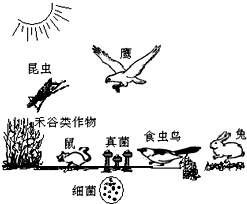问题
填空题
如图为某农田生态系统组成示意图,据图回答在关问题.
(1)该生态系统中的生产者是______,分解者是______.
(2)食虫鸟和昆虫之间的关系是______,兔与昆虫、鼠的关系是______.
(3)写出其中最长的一条食物链:______.

答案
(1)生产者主要指绿色植物,能够通过光合作用制造有机物,为自身和生物圈中的其他生物提供物质和能量,因此该生态系统中的生产者是和谷类作物;分解者是指细菌和真菌等营腐生生活的微生物,因此分解者是真细菌、真菌.
(2)食虫鸟吃昆虫,因此食虫鸟和昆虫之间的关系是捕食关系,兔与昆虫、鼠相互争夺食物和谷类作物,因此属于竞争关系.
(3)此生态系统中共有三条食物链.①禾谷类→昆虫→食虫鸟→鹰,②禾谷类→兔→鹰,③禾谷类→鼠→鹰.最长的食物链是禾谷类→昆虫→食虫鸟→鹰.
故答案为:
(1)禾谷类植物;细菌、真菌;
(2)捕食关系;竞争关系;
(3)禾谷类→昆虫→食虫鸟→鹰;
